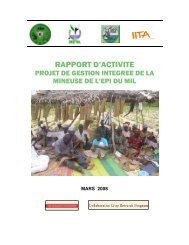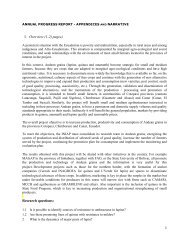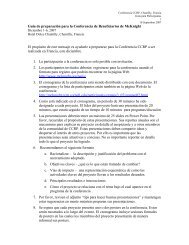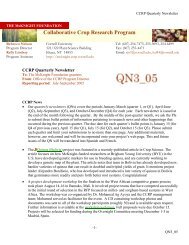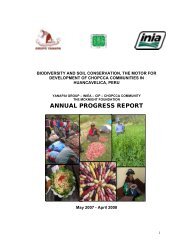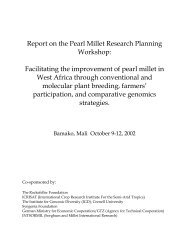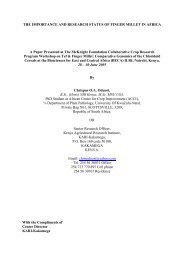English - McKnight Foundation Collaborative Crop Research Program
English - McKnight Foundation Collaborative Crop Research Program
English - McKnight Foundation Collaborative Crop Research Program
Create successful ePaper yourself
Turn your PDF publications into a flip-book with our unique Google optimized e-Paper software.
<strong>McKnight</strong> <strong>Foundation</strong> <strong>Collaborative</strong> <strong>Crop</strong>s <strong>Research</strong> Project No: 06-741<br />
Development and promotion of Alectra resistant cowpea cultivars for<br />
smallholder farmers in Malawi and Tanzania<br />
With regard to cowpea leaves, it was observed that the leaves are consumed by almost all<br />
in the two communities surveyed. The young leaves are the ones normally picked,<br />
usually the first three or four from the cowpea plant. While some chop the leaves into<br />
small pieces before cooking, others boil the whole leaves. The leaves seem to have a big<br />
contribution with regard to calcium, iron and zinc. According to Schippers (1997)<br />
African Indigenous Vegetables (AIVs) play a highly significant role in food security of<br />
the under-privileged in both urban and rural settings. AIVs have traditionally taken an<br />
important role in African diets, being used both as medicine and as a vegetable. Many of<br />
these crops are highly nutritious, easy and cheap to grow.<br />
Results indicate that, there was twice as much calcium in leaves than in cowpea grains<br />
and almost 40 times as much iron. Similar results were observed by Weinberger et al.<br />
(2004) where indigenous vegetables showed high mineral levels. Since the iron and zinc<br />
levels in cowpea leaves have shown to be significantly higher than the levels in cowpea<br />
grains, creating more awareness and encouraging the utilization of cowpea leaves will<br />
contribute to alleviating micronutrient deficiencies from cheap sources especially in<br />
resource-poor families. However, it is also important to note that, vegetables that are<br />
common in a particular locality do not necessarily have values of iron contents that are<br />
comparable. For example, in a study by Weinberger et al. (2004) it was reported that<br />
cowpea leaves were identified and collected from four districts in Tanzania, their values<br />
were quite different varying from 179.0 mg in Kongwa, 66.0 mg in Singida, 77.5 mg in<br />
Muheza and 187.0 mg in Arumeru, per kg of edible portion. This is evident that the<br />
amount of minerals found in these vegetables does differ not only according to type of<br />
vegetable but also according to the place, location or district where they were obtained.<br />
This shows that the soil mineral content might have an influence in mineral uptake of the<br />
plants. This aspect can be further investigated.<br />
Adequacy of cowpea consumed in households<br />
As revealed in the results, the daily per capita consumption for the majority of the<br />
households surveyed ranged from 41 to 200 grams of cowpea, which means using the<br />
Atwater factors (4 kcal/g carbohydrates, 4 kcal/g protein and 4 kcal/g fats) an individual<br />
obtained about 135 to 658 kcal per day. Considering that a normal adult requires about a<br />
supply of 2500 kcal per day to perform moderate activities, the other amount of food<br />
eaten in conjunction with cowpeas such as rice or maize flour cannot fill the remaining<br />
gap. This shows that the amount of cowpeas consumed by most households does not<br />
satisfy daily requirements as the quantity eaten is inadequate. In the case of the developed<br />
varieties, which are higher yielding and resistant to Alectra, they will probably be<br />
accepted by the communities and the amount per capita of cowpeas consumed should<br />
increase provided they continue to cultivate the same area of land.



